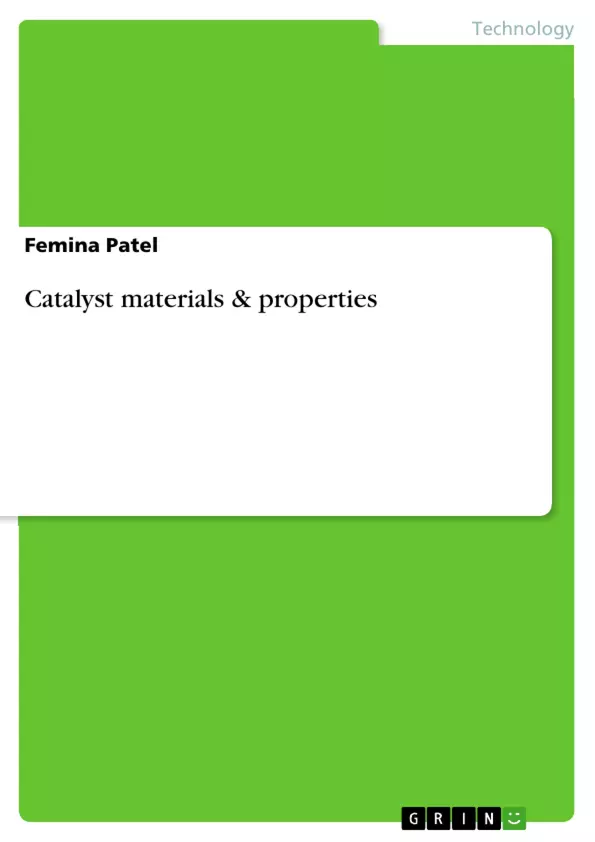Catalysis has made a rapid progress and there can be observed many new applications of catalysts. Heterogeneous and homogeneous catalysts used commercially are chemically and physically complex, sophisticated materials and because of the chemical and physical complexity of catalysts, catalyst research and development is highly multidisciplinary field which require knowledge of chemistry, chemical engineering, material science and physics. In order to design, develop and prepare new catalysts, a process which requires detailed knowledge of catalyst material, catalyst properties and art/science of catalyst preparation. The main objective of this book is to present an overview on catalyst materials and properties so that both the student and the experienced practitioner can understand the concept of catalyst materials and properties.
Table of Contents
- 1. Introduction
- 1.1 Catalyst Performance
- 2. Catalyst Materials
- 2.1 Makeup of a typical heterogeneous catalyst
- 2.2 Active catalytic phases
- 2.2.1 Selecting the active catalysts
- 2.3 Carriers (Supports)
- 2.3.1 Alumina
- 2.3.2 Silicas
- 2.3.3 Carbons
- 2.3.4 Titania
- 2.3.5 Synthesis of zeolites and mesoporous materials
- 2.3.6 Other supports
- 2.3.6.1 Monolith Support
- 2.3.7 Selecting the right support
- 2.4 Promoters
- 2.5 Inhibitors
- 3. Catalyst Properties
- 3.1 Introduction
- 3.2 Physical, mechanical and chemical properties
- 3.2.1 Physical and mechanical properties, their definition and their Importance
- 3.2.2 Chemical Properties
- 3.2.3 Dynamic properties
- 3.3 Catalyst characterization
Objectives and Key Themes
The main objective of this book is to provide a comprehensive overview of catalyst materials and properties, catering to both students and experienced practitioners. It aims to enhance understanding of the fundamental concepts related to catalyst materials and their characteristics.
- The composition and structure of heterogeneous catalysts.
- The selection and properties of active catalytic phases, supports, and promoters.
- The physical, mechanical, and chemical properties of catalysts.
- Methods for catalyst characterization.
- The importance of catalyst properties in determining catalyst performance.
Chapter Summaries
1. Introduction: This introductory chapter sets the stage for the book by highlighting the significant advancements in catalysis and its diverse applications. It emphasizes the multidisciplinary nature of catalyst research and development, requiring expertise from chemistry, chemical engineering, materials science, and physics. The chapter underscores the necessity of a deep understanding of catalyst materials and properties for the successful design, development, and preparation of new catalysts.
2. Catalyst Materials: This chapter delves into the detailed composition and structure of heterogeneous catalysts. It thoroughly explores the roles of active catalytic phases, carriers (supports), promoters, and inhibitors, and how the selection of each component significantly influences the overall catalyst performance. Subsections discuss various support materials like alumina, silica, carbons, and titania, along with methods for synthesizing zeolites and mesoporous materials, providing a comprehensive overview of catalyst design elements. Specific examples and detailed explanations of each component and its impact on the catalytic process are provided.
3. Catalyst Properties: This chapter focuses on the characterization and understanding of various catalyst properties, including their physical, mechanical, and chemical attributes. It explains the importance of these properties in determining catalyst performance and efficiency, emphasizing the interrelationship between structure and function. The chapter further examines dynamic properties and provides a detailed discussion on various methods used to characterize catalysts, ensuring that readers gain a practical understanding of the essential properties to consider in catalyst design and evaluation.
Keywords
Catalyst materials, catalyst properties, heterogeneous catalysis, active phases, supports, promoters, inhibitors, alumina, silica, carbons, zeolites, mesoporous materials, catalyst characterization, physical properties, mechanical properties, chemical properties, catalyst design, catalyst performance.
Frequently Asked Questions: A Comprehensive Language Preview of Catalyst Materials and Properties
What is the main focus of this book?
This book provides a comprehensive overview of catalyst materials and properties, suitable for both students and experienced professionals. It aims to enhance understanding of fundamental concepts related to catalyst materials and their characteristics, including composition, structure, and performance.
What topics are covered in the Table of Contents?
The book covers three main sections: An introduction to catalysis and its importance; a detailed exploration of catalyst materials, including active phases, supports (like alumina, silica, carbons, titania, zeolites, and mesoporous materials), promoters, and inhibitors; and a thorough examination of catalyst properties (physical, mechanical, chemical, and dynamic properties) and their characterization methods.
What are the key objectives and themes of the book?
The book aims to explain the composition and structure of heterogeneous catalysts; the selection and properties of active catalytic phases, supports, and promoters; the physical, mechanical, and chemical properties of catalysts; methods for catalyst characterization; and the importance of catalyst properties in determining catalyst performance.
What are the key takeaways from each chapter?
Chapter 1 (Introduction): This chapter introduces the significance of catalysis, its diverse applications, and the multidisciplinary nature of catalyst research and development. It emphasizes the importance of understanding catalyst materials and properties for successful catalyst design.
Chapter 2 (Catalyst Materials): This chapter delves into the detailed composition and structure of heterogeneous catalysts, exploring the roles of active phases, supports, promoters, and inhibitors and how their selection impacts overall catalyst performance. Various support materials and synthesis methods are discussed.
Chapter 3 (Catalyst Properties): This chapter focuses on the characterization and understanding of catalyst properties (physical, mechanical, and chemical), their importance in determining performance, and the methods used for catalyst characterization.
What keywords describe the content of this book?
Catalyst materials, catalyst properties, heterogeneous catalysis, active phases, supports, promoters, inhibitors, alumina, silica, carbons, zeolites, mesoporous materials, catalyst characterization, physical properties, mechanical properties, chemical properties, catalyst design, catalyst performance.
Who is the target audience for this book?
The book is designed for both students and experienced practitioners in the field of catalysis, providing a comprehensive overview of catalyst materials and properties.
- Quote paper
- Femina Patel (Author), 2014, Catalyst materials & properties, Munich, GRIN Verlag, https://www.hausarbeiten.de/document/275585


